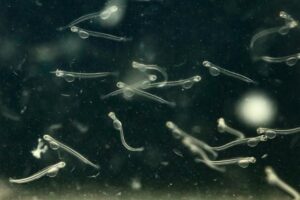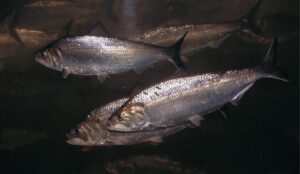According to a MassWildlife news release, two members of the MassWildlife prescribed fire crew, Connor Fleming and Ben Mazzei, recently departed for Quebec, Canada to help battle some of the more than 70 wildfires that have continued to burn since the beginning of June. Fleming and Mazzei join 14 other wildland firefighters from the Massachusetts Department of Conservation and Recreation (DCR).
The crew will travel to Quebec, where they will be assigned to one of many ongoing fire incidents throughout the province. The 16 Massachusetts firefighters will be joined by four firefighters from Connecticut and one from Vermont. They will engage in direct fire suppression, working on the fire line for about 14 days—building fire breaks, securing fire perimeters, containing fires, and protecting structures.
Rising temperatures, drier conditions due to years of long droughts, and a lack of rain and snowfall, all caused by climate change, are fueling increased fire activity, making the fire season last longer and its effects more severe. The fires in Quebec are just the latest in a series of wildfires burning across Canada this year, including those in Nova Scotia, which resulted in major smoke impacts across the northeastern United States.
“These wildfires are continuing to rage, burning millions of acres of land and blowing smoke into Massachusetts that’s polluting our air,” said DCR Commissioner Brian Arrigo. “I’m proud that we are sending another crew of well-trained and dedicated firefighters to help our friends and partners in Quebec battle these intense blazes and stop further destruction of forests.”
“Fueled by climate change, wildfires are negatively impacting public health, forest health, carbon sequestration and biodiversity here in Massachusetts and throughout North America,” said Department of Fish & Game (DFG) Commissioner Tom O’Shea. “We are extremely grateful to the dedicated staff from DCR and DFG who have volunteered for this important and difficult assignment.”
Massachusetts, along with the other New England states and New York, established the Northeastern Forest Fire Protection Compact—also called the Northeast Compact—in 1949. The Compact provides a means for member states to cope with wildland fires that may become too intense for a single member state to control.
MassWildlife awarded $773K to address wildlife diseases
The funds came from a Zoonotic Disease Initiative grant funds from the U.S. Fish and Wildlife Service. These funds will be used over a 3-year period to develop a wildlife health and public outreach program for Massachusetts and to research wildlife diseases and prevent their spread within the Northeast region.
Zoonotic diseases are defined as those that can be transmitted between wildlife and humans. This federal funding provides grants to states, Tribes, and territories to address wildlife disease outbreaks before they become pandemics. The highest priority for the initiative is to increase organizational readiness and ensure there is a network of partners across the nation who are prepared to respond to zoonotic disease outbreaks. Strengthening partner capacity for wildlife health monitoring will allow for the early detection of diseases.
“Recent disease issues like Highly Pathogenic Avian Influenza in birds and white-nose syndrome in bats have highlighted the need for building capacity within MassWildlife and other groups in the region to respond quickly using the latest science and best practices,” said Mark S. Tisa, Director of MassWildlife. “This funding will help us formalize working relationships with our partners to conduct surveillance and improve public outreach.”
The U.S. Fish and Wildlife Service’s One Health approach to zoonotic diseases includes working closely with experts who specialize in public, animal, and ecosystem health to develop comprehensive plans and appropriate responses to zoonotic disease events. This funding will provide critical financial resources to agencies like MassWildlife who can help prevent and combat global pandemics before they start.
Grants awarded under the Zoonotic Disease Initiative will be used to establish and enhance the capabilities of Tribal, state, and territorial fish and wildlife agencies to effectively address health issues involving free-ranging terrestrial, avian, and aquatic wildlife. Authorized under the American Rescue Plan (2021, H.R. 1319, Section 6003.3), the Initiative will provide up to $9 million in funding to strengthen early detection, rapid response, and science-based management research to address wildlife disease outbreaks before they cross the barrier from animals to humans and become pandemics
Under the direction of MassWildlife, the new program will be guided by an interagency task force of subject area experts and cooperating partners, including the Massachusetts Division of Marine Fisheries, Massachusetts Department of Public Health, Massachusetts Department of Agriculture, Cornell University, UMass-Amherst, University of New Hampshire, Tufts University, Massachusetts Department of Environmental Protection, Massachusetts Emergency Management Agency, Wampanoag Tribe of Aquinnah, Mashpee Wampanoag Tribe, and USDA Wildlife Services.
Shad stocking underway
The following information was provided by MassWildlife Fisheries Biologist, Steven Mattocks.
American shad are fish that migrate from oceans to rivers every spring to spawn. They were once abundant in large Massachusetts rivers like the Taunton, but now only a small portion of their historical population remains. To help increase their numbers, MassWildlife, the Division of Marine Fisheries, and the U.S. Fish and Wildlife Service have begun stocking larval shad.
Fish, like American shad, that spend portions of their lives in both the ocean and freshwater rivers, are known as diadromous fish. Special techniques are needed to restore these migratory fish so that they become connected to a certain freshwater location. Tiny shad, just a few hours old and still attached to their egg sacks, are stocked in the Taunton so that they can “imprint” on the unique characteristics of the river. This will aid in their navigation back to the Taunton when they return as adults after spending 3–5 years in the ocean. Approximately 2 million larval shad will be stocked in the Taunton River each year over the next for 5 years.
. The U.S. Fish and Wildlife Service began stocking in 2022. Monitoring will continue over the next several years to document population changes in response to the stocking effort. The goal of this partnership is to restore a strong, self-sustaining shad population, and to someday open the fishery to recreational harvest.
American shad are stocked in the Taunton River when they are only a few hours old.
Taunton River once teemed with river herring, shad, and other diadromous fish. However, during the industrial revolution these populations plummeted due to pollution, overfishing, and the construction of multiple dams that blocked passage of migratory fish. Today, water quality improvements and an increase in habitat quality and quantity through dam removal have allowed for the opportunity to bring back this historically important fishery.
This shad restoration effort is part of a larger conservation story for the Taunton. Recent dam removals on Mill River—a tributary of the Taunton—and water quality improvements have led to a rebound in the number of river herring in that system. The once diminished river herring population, which includes both alewife and blueback herring, is thriving and the Taunton and is now home to one of the largest river herring runs in the state. River herring numbers in the Mill River have increased from 1,000 fish in 2013 to over 31,000 fish in 2021.
MassWildlife, the Division of Marine Fisheries, and the U.S. Fish and Wildlife Service will continue this collaborative restoration and monitoring work in the Taunton with the goal of returning the American shad population closer to historical levels.


